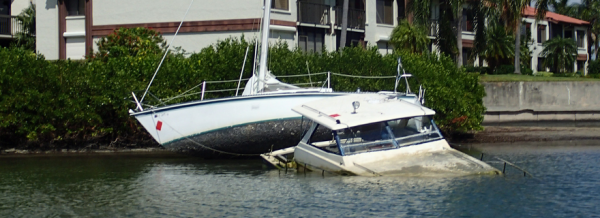
Along with the more visible debris on the side of the road, our waterways were not spared Hurricane Irma’s impacts — strong winds and waves destroyed boats in our sensitive coastal habitats. Boats all over the state were torn from their moorings and tossed far and wide. Many were simply abandoned to become an especially troublesome form of “marine debris.”
Removing these boats, usually referred to as derelict vessels, without causing additional damage takes effort. Luckily, through a collaboration between the Florida Department of Environmental Protection (DEP), the United States Coast Guard, Florida Fish and Wildlife Conservation Commission’s Division of Law Enforcement (FWC) and private contractors, great care is being taken to protect Tampa Bay’s seagrasses, coastal wetlands and waters.
Derelict boats are a common issue every year, and there is never enough money to remove them all – and not all of them will be removed as quickly as some people would like. It can be tricky to determine which boats were grounded by Irma, and will likely cause future damage. Some boats were derelict prior to Irma, and are the subject of current litigation, so they could not be removed during the current effort. In Tampa Bay alone, 86 boats were removed and stored in a large yard in Tampa.
Removing these boats is complicated from multiple perspectives – without including the sheer volume of extra boats from the storm. Private ownership issues (and the owner’s responsibility to remove the boat from public waters) as well as the lack of funding for what can be a very expensive process are both difficult issues. Sometimes, simply identifying the responsible owner is a huge obstacle.
These dedicated teams were on the water for 2 to 3 months, including weekends, with the partnerships still going strong and making progress in clearing these boats from the bay and other coastal waters. Tampa Bay was spared the worst. Across the state, approximately 2,600 boats were displaced due to the hurricane, the Keys being the most impacted by having approximately 1,600 displaced boats. These numbers are preliminary, as efforts are still ongoing.
Each entity plays a critical role in the process of removing derelict boats, usually referred to as derelict vessels. The Coast Guard coordinates and oversees the private contractors. DEP ensures impacts to natural resources are avoided during removal. FWC identifies derelict boats and monitors compliance with regulations governing removal. The private contractors play the most visible role, bringing in barges with cranes to remove the boats. Even though each entity plays a different role, the collaboration is proving effective.
Many of the private contractors that are working to remove these storm-related derelict boats are fishermen themselves, who come from around the country and understand the need to avoid damaging productive fish habitat, including important benthic (bottom) habitats with active invertebrate colonies, seagrasses and coastal wetlands.


 Advertising
Advertising